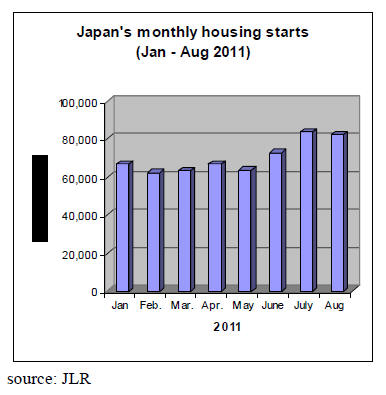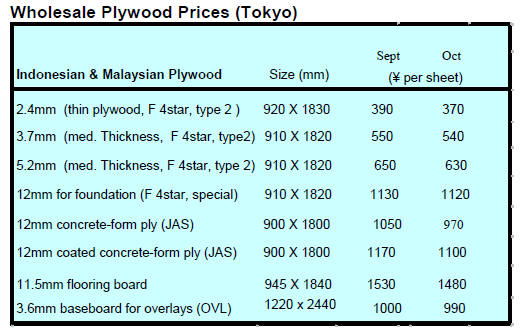Japan Wood Products
Prices
Dollar Exchange Rates of
15th October 2011
Japan Yen 77.26
Reports From Japan
Active Asian demand for tropical logs halts slide in log prices
Tropical log prices quoted for the Japanese market, which
had been falling since June, have leveled out says the
Japan Lumber Reports (JLR). This, says the JLR, is
because buyers in India and Taiwan P.o.C have become
more active in the market.
Tropical log suppliers in Malaysia have become more
bullish and are moving to raise prices across the board.
Meranti regular log FOB prices are up by US$10 per cubic
metre FOB compared levels in August.
The JLR reports that current price quotes are at US$275-
320 per cu.m FOB for regular Meranti logs. Prices for
small and super small Meranti logs have also moved up by
around US$5 per cu.m.
In a reaction to the latest round of increases Japanese
buyers suggest that US$300 per cu.m FOB for Meranti is
just too high for this market and that at this price the
consumption of tropical logs in Japan will start to decline.
In the producer regions in SE Asia the rain season is
approaching so log supplies will fall again over the next
few months and this shortage will result in further price
increases in the short term.
In the wholesale market in Japan Meranti regular log
prices recently peaked at Yen 10,000 per koku but the
combined effect of weakening FOB prices and the
appreciation of the Yen, the prices are now 9,200-9,300
yen per koku CIF.
Bad weather in PNG and Solomon Islands hampering harvesting
The JLR is reporting that bad weather is hampering
harvesting in Papua New Guinea and the Solomon Islands
and that log stocks have fallen.
China is the dominant buyer of logs from these two
countries and Japan cannot compete for logs from the
region as wholesale log prices in Japan continue to fall.
Plywood mills in Japan shift to softwoods as tropical
log prices too high
Most of the tropical logs imported into Japan are used for
the manufacture of plywood. At the moment the market
for hardwood plywood is extremely poor and mills are not
able to make a profit with log prices at current levels.
As a result mills have stopped manufacturing unprofitable
lines such as tropical hardwood structural and concrete
formboard panels and have shifted to producing more
softwood plywood.
Five consecutive monthly increases in housing starts recorded
Total housing starts in Japan during August were 81,986
units, 14% more than the same month a year ago report the
JLR. This represents five consecutive monthly increases. It
was found that monthly housing starts were over 80,000
units for two straight months.

Japan Forestry Association offers suggestions for revising taxes
Groups within the Japan Forestry Association recently had
the opportunity to present suggestions for revising the tax
structures for forestry and forest industry enterprises.
To promote revitalisation of the forest and forest industry
sectors the Association submitted the following
suggestions.
• Establish a new tax system to promote
maintenance of the forest and utilisation of wood.
• Establish a new structure for payment of
inheritance and gift taxes.
• Set up a tax exemption or refund measure on
taxes imposed on oil and coal.
• Extend the reduced tax on light oil transaction
tax.
• Expand the special tax measure on business
office tax.
• Reduce the property tax.
• Reduce income tax on forest revenue.
• Extend the reduction on income and corporate
taxes.
• Reduce consumption tax on wood trading.
Japanese house builders increase use of laminated
lumber for posts and beams
The Japan Forest Products Journal has once more
surveyed house builders on their use of wood products. In
its thirteenth survey of 61 house builders it was found that
the use laminated lumber for posts and beams has
increased further.
Overall it was found that the use of laminated lumber for
house post amounted to 72%, which is close to the record
use found in 2002. For beams the use of laminated lumber
was found to have increased by 10% bring overall use
across the industry to 69%.
The use of laminated lumber for use as sills was found not
to have changed since the last survey.


Related News:
|